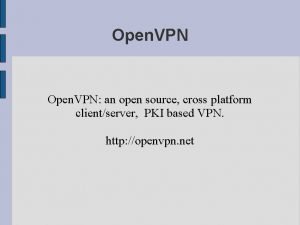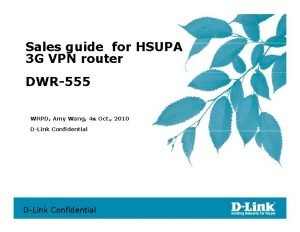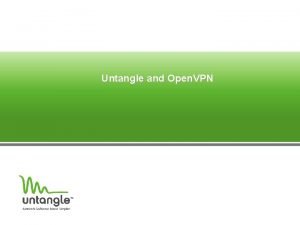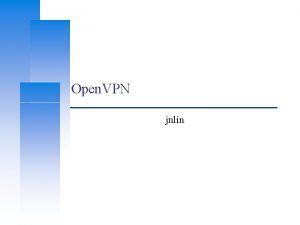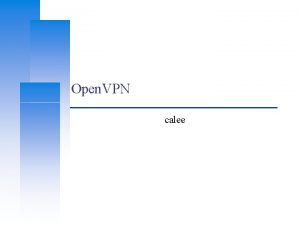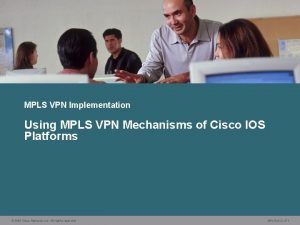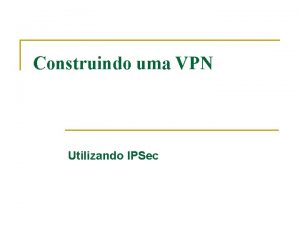Open VPN Computer Center of Department of Computer













![Sign key to CA # cd /root/ca # easyrsa import-req /usr/local/etc/openvpn/pki/reqs/[NAME]. req [NAME] # Sign key to CA # cd /root/ca # easyrsa import-req /usr/local/etc/openvpn/pki/reqs/[NAME]. req [NAME] #](https://slidetodoc.com/presentation_image_h2/0e2e66f638c868f956fe64cb882c5151/image-14.jpg)







- Slides: 21

Open. VPN 國立陽明交通大學資 系資訊中心 Computer Center of Department of Computer Science, NYCU

Why Open. VPN 1. Cross-platform portability a. i. OS / Android / Windows / Linux / Free. BSD b. Open. WRT 2. Extensible VPN framework a. Logging b. Authentication 3. Open. VPN uses an industrial-strength security model 2

TUN/TAP ● TUN ○ ○ ○ ○ ○ Layer 2 behave like adapter More overhead(L 2) Transfer any protocol Bridge Layer 3 Less Overhead(L 3) Only IPv 4 , IPv 6(Open. VPN 2. 3) No Bridges! 3

Configuring Open. VPN l A server/client setting can be described as a ovpn/conf file. l At most circumstances, we will separate key/ca files to make config file clean. 4

Configuration ● /usr/local/etc/openvpn. conf ○ copy ■ From: /usr/local/share/examples/openvpn/sample-config-files/server. conf ■ To: /usr/local/etc/openvpn. conf ● In /etc/rc. conf. local ○ openvpn_enable="YES" ○ openvpn_configfile="/usr/local/etc/openvpn. conf" 5

A simple server config(1/2) port 1194 proto udp dev tun ca ca. crt cert server. crt key server. key # This file should be kept secret dh dh 2048. pem topology subnet server 192. 168. 14. 0 255. 0 ifconfig-pool-persist ipp. txt client-config-dir static_clients push "redirect-gateway def 1 bypass-dhcp" push "dhcp-option DNS 8. 8" push "dhcp-option DNS 8. 8. 4. 4" client-to-client 6

A simple server config(2/2) keepalive 10 120 tls-auth ta. key 0 # This file is secret cipher AES-256 -CBC # AES comp-lzo max-clients 10 user nobody group nobody persist-key persist-tun verb 5 mute 20 7

A simple client config client dev tun proto udp remote xxx. com 1194 resolv-retry infinite nobind persist-key persist-tun ca ca. crt cert client. crt key client. key remote-cert-tls server tls-auth ta. key 1 cipher AES-256 -CBC comp-lzo verb 3 mute 20 8

X. 509 PKI Root CA Server Certificate Revocation List Client Certificate Subordinate Signing CA Certificate Revocation List Server Certificate Client Certificate Subordinate Signing CA Entire Structure Repeats as needed 9

Diffie Hellman parameters ● Diffie–Hellman is used to secure a variety of Internet services. However, research published in October 2015 suggests that the parameters in use for many D-H Internet applications at that time are not strong enough to prevent compromise by very well-funded attackers, such as the security services of large governments. (wikipedia) ● Generate 2048 -bit dhparams! 10

HMAC ● tls-auth ● The tls-auth directive adds an additional HMAC signature to all SSL/TLS handshake packets for integrity verification. Any UDP packet not bearing the correct HMAC signature can be dropped without further processing. The tlsauth HMAC signature provides an additional level of security above and beyond that provided by SSL/TLS. It can protect against: ○ ○ Do. S attacks or port flooding on the Open. VPN UDP port. Port scanning to determine which server UDP ports are in a listening state. Buffer overflow vulnerabilities in the SSL/TLS implementation. SSL/TLS handshake initiations from unauthorized machines (while such handshakes would ultimately fail to authenticate, tls-auth can cut them off at a much earlier point). 11

Generate ca, cert 1. Use easy-rsa, an openvpn ca, cert generate tool 2. Do it from scratch with openssl ※Question: Can we generate certificates using Let’s Encrypt? Pros & Cons ? 12

easy-rsa ● In Free. BSD: # pkg install easy-rsa # # mkdir /root/ca cd /root/ca easyrsa init-pki easyrsa build-ca # # cd /usr/local/etc/openvpn/ easyrsa init-pki easyrsa gen-req [NAME] nopass easyrsa gen-dh # # mkdir /root/client cd /root/client easyrsa init-pki /easyrsa fen-req [NAME] https: //community. openvpn. net/openvpn/wiki/Easy. RSA 3 -Open. VPN-Howto 13
![Sign key to CA cd rootca easyrsa importreq usrlocaletcopenvpnpkireqsNAME req NAME Sign key to CA # cd /root/ca # easyrsa import-req /usr/local/etc/openvpn/pki/reqs/[NAME]. req [NAME] #](https://slidetodoc.com/presentation_image_h2/0e2e66f638c868f956fe64cb882c5151/image-14.jpg)
Sign key to CA # cd /root/ca # easyrsa import-req /usr/local/etc/openvpn/pki/reqs/[NAME]. req [NAME] # easyrsa import-req /root/client/pki/reqs/[NAME]. req [NAME] # easyrsa sign-req server [NAME] # easyrsa sign-req client [NAME] 14

Diffie-Hellman / TLS-auth key DH-KEY # cd /usr/local/etc/openvpn # easyrsa gen dh AUTH KEY (Server & Client) # cd /usr/local/etc/openvpn # openvpn -genkey -secret ta. key 15

Package your config ● Server ○ ○ ○ ca. crt server. conf server. key server. crt dh. pem ta. key ● Client ○ ○ ○ ca. crt client. conf client. key client. crt ta. key 16

Enable and start ● SERVER SIDE # cp keys, conf, crts. . . /usr/local/etc/openvpn # /usr/local/etc/rc. d/openvpn start ● CLIENT SIDE # cp keys, conf, crts. . . /usr/local/etc/openvpn # /usr/local/etc/rc. d/openvpn start 17

User-authentication 1. Simply by signing client certs. 2. Username/password 3. Use 3 rd party authentication ● RADIUS ● LDAP 18

Server Side Inside server. conf # Using PAM to auth (Working with LDAP/NIS/Local Accout) (verify-client-cert) plugin /usr/local/lib/openvpn/plugins/openvpn-plugin-auth-pam. so login # Use a shell script to auth-user-pass-verify /etc/openvpn/auth. sh via-env script-security 3 # To allow script reading passwords Reference: ● /usr/share/doc/openvpn-2. 4. 6/README. auth-pam ● /etc/pam. d/login 19

Client Side # A dialog will popup to ask you username/password auth-user-pass # Saving username/password into a file auth-user-pass client. secret # cat client. secret Client. Name Client. Password 20

Reference ● https: //www. digitalocean. com/community/tutorials/how-to-setup-andconfigure-an-openvpn-server-on-centos-7 ● https: //www. howtoforge. com/tutorial/how-to-install-openvpn-on-centos-7/ ● https: //wiki. archlinux. org/index. php/Open. VPN 21
 Ipsec vs ssl vpn
Ipsec vs ssl vpn Ncsu vpn
Ncsu vpn 영국 beis
영국 beis Open source vpn client
Open source vpn client Maksud vpn 555
Maksud vpn 555 Chapter 4 fire service communications quiz
Chapter 4 fire service communications quiz Relay timer symbol
Relay timer symbol Open hearts open hands
Open hearts open hands Gravitational wave open science center
Gravitational wave open science center Closed center curls
Closed center curls Finger waving is the process of
Finger waving is the process of What are the four basic curl patterns
What are the four basic curl patterns Name the 4 pin curl bases and their uses
Name the 4 pin curl bases and their uses Ucl computer science department
Ucl computer science department Electrical engineering northwestern
Electrical engineering northwestern Computer science department rutgers
Computer science department rutgers Stanford computer science department
Stanford computer science department Fsu cs faculty
Fsu cs faculty Tum department of electrical and computer engineering
Tum department of electrical and computer engineering Ubc computer science department
Ubc computer science department Department of computer science christ
Department of computer science christ Computer engineering department
Computer engineering department



